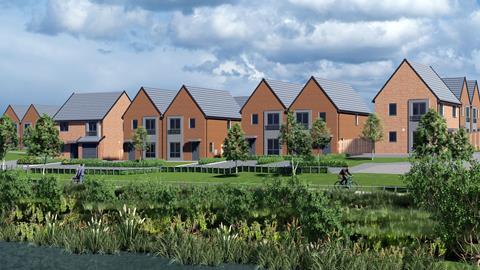Exclusive data and full analysis on the biggest homebuilders in the UK

It might not have felt like it at the time, but 2021 was actually a good year to be a housebuilder. That’s not to say it was easy – but the numbers in this year’s Top 50 Housebuilders tables, compiled from the most recent published results of the UK’s biggest private residential developers, tell a pretty simple story.
Housebuilders in the top 50 saw their turnover increase by an average of more than 25%, taking revenue well above pre-pandemic levels, with operating profit across the firms increasing even faster, by a third. Operating margins, which rose to 11.7% on average, were close to the levels seen pre-covid.
>> Click here to see the full Top 50 Housebuilders 2022 table <<
Of course, given the mini-Budget turmoil and new chancellor , this all feels like a long time ago. Developers now face very different challenges to the ones posed in the period covered by these accounts – the most recent of which run to July this year. Since 23 September, by between 40% and 50% as the cost of mortgages has soared, and big questions are being asked about what 2023 will hold for the sector.
Here, Housing Today looks back at the industry’s stellar performance, and asks what the data says about which firms are best placed to face the coming storm.
Rebound effect
According to Housing Today’s analysis, the UK’s 50 biggest firms pulled in £38.6bn in revenue in their most recent accounts, up from £31.8bn last year, generating a healthy £5.6bn of operating profit at an 11.7% margin – up from 7.8% last year (note: these totalled figures are not directly comparable to the numbers we published last year here, as then we only ranked the top 35 housebuilders). Barratt remained the UK’s biggest builder by turnover, Persimmon the one generating the most operating profit.

The year-end dates of the housebuilders within the tables varied, but a large number covered the 2021 calendar year, meaning that there is a large element of covid recovery within these numbers, from firms where the previous figures had been marred by two months of enforced lockdown.
Clyde Lewis, deputy head of research at analyst house Peel Hunt, says: “Of course 2020 was covid hit, so you’ve obviously got a very easy comparator. That on its own explains a great deal of the growth.”
Bob Weston, chairman of privately held Essex-based housebuilder Weston Homes, which slipped from 26th to 27th in the table despite posting 20% turnover growth to £214m, says the year has been about building back to “pre-pandemic levels of profitability” – for which Weston was about 60% of the way there.
But, of course, last year’s growth not only reflects a rebound effect from the 2020 lockdown – a number of the firms had already incorporated that rebound in last year’s figures. It also reflects the unprecedented two-year housing market romp sparked by the lockdown reassessment of people’s housing needs and exacerbated by then-chancellor Rishi Sunak’s stamp duty cut.
James Thomson, chief executive of Gleeson, which hopped just one place up the tables to 17th despite a 29% leap in turnover to £373m, says the biggest reason for the performance in the year was “very strong structural demand from first-time buyers for affordable new-build homes in the geographies in which we operate”.
He added: “We were selling as much as we could build – the thing holding us back was the ability to get sites.”
Challenges
There were significant challenges during this period – not in selling homes but in delivering them. Nowhere was this challenge more acute than in securing materials. Shane Carberry, building analyst at Irish analyst Goodbody, says: “Initially the challenge post-pandemic was getting your hands on products, given supply chain shortages. Then, from late 2021, it was the level of inflation – which became fairly exceptional.
“The PLCs have had the buying power in this inflationary environment, and it has been harder for the smaller builders.”
“We were selling as much as we could build – the thing holding us back was the ability to get sites”
James Thomson, Gleeson
Gleeson’s Thomson says he even resorted to shipping materials between live sites in order to keep construction going when suppliers let the housebuilder down. “We took some pretty unusual actions that we wouldn’t normally do, but fortunately we were able to keep sites going,” he says. Given significant house price rises and the huge demand for homes, housebuilders were able to increase operating profit, which rose 33% for the top 50 despite the materials shortages.

But margins did not return to their pre-pandemic level – Housing Today reported margins of 12.3% in the top 35 prior to the pandemic as opposed to 11.4% for the top 35 in this year’s selection – which can be blamed on the competition for materials, workers and, increasingly, land.
Thomson is one of many to also cite planning as a significant inhibitor on sector growth during this period of bounce-back, in not delivering enough sites to the housebuilding industry. He estimates the time taken to achieve planning approval has doubled since the pandemic, from around seven or eight months prior to 2020.
Thomson is not alone. A Persimmon spokesperson says these planning delays contributed to its lower growth in the 2021 calendar year, which saw it slip back from second to third place in the table. “In simple terms we didn’t have the outlets to enable us to build fast enough,” the spokesperson says.
Recession
From the current outlook, it is tempting to view these as nice problems to have. Right now, the industry is facing predictions of the longest recession on record, with the Office for Budget Responsibility estimating completions will drop by 25% from current levels by 2025/26 as house prices fall 9.2% peak-to-trough.
Sales rates have slumped, commonly to under 0.5 sales per site per week, according to those housebuilders that have reported trading updates. To cap it all, the government has just for first-time buyers at the exact moment that a shift in the mortgage market has put homes out of reach of many. Listed housebuilders as a sector have lost nearly half of their value during 2022.
However, there remains optimism among residential developers that the situation will not end up as bad as many fear. The case for positivity rests on the idea that mortgage rates have already peaked, alongside the continuing strength of both the employment market and rental prices.
>> See also: Help to Buy: It’s the end of an era
>> See also: What are housebuilding’s prospects in the wake of the mini-Budget?
Tony Williams, analyst at ��ɫ����TV Value, says: “The key thing is employment is holding up – that’s the best indicator of demand, and rents keep going up. So, the likes of Gleeson are still able to say it’s cheaper to buy than to rent.”
Peel Hunt’s Lewis adds that the strength of rental prices means “the truth is people are going to have to reassess what they spend on their housing costs”.
Weston Homes’ Bob Weston says: “I think the market will stay dry until January or February, as sentiment around interest rates becomes a little bit more normal, rather than the shock. Output will go down.
“But logic tells us that by about February, as we launch to go into the spring/summer, undersupply in the market will stoke demand. It will be to a level that we need – it’s not that we’re booming – enough to hold the business.”
Write-downs
Likewise, Earl Sibley, newly promoted chief operating officer at Vistry, says he is “cautiously optimistic” for trading next year, given the “stability” coming back in the financial market in recent weeks, which has seen for the first time since the immediate aftermath of the mini-Budget. He says Vistry is not dropping its house prices.
“Employment is still good, some people are getting good pay rises, while [the] renting [market] is bonkers in many parts of the country, and the undersupply of housing gets worse by the year,” he adds.
“The truth is people are going to have to reassess what they spend on their housing costs”
Clyde Lewis, Peel Hunt
Most housebuilders are protected by the fact they are in good financial shape, having learnt the lessons of the 2008 financial crisis, when the biggest players were brought to their knees due to their significant debts. Nevertheless, major house price falls could still see some forced to make write-downs, says Clyde Lewis, with Crest Nicholson seen as the most vulnerable to this among the listed builders.
“We aren’t going to see desperation rights issues to raise money, and these firms don’t need to run their businesses for cash,” he says. “But write-downs are possible. If prices fall around 5% it will be pretty limited, but if they go down 10% it will be much more widespread.”
Analysts say that those best placed to weather the coming storm will be those with the soundest finances, positive forward order books, a strong sales and marketing function, and customers less reliant on mortgages to purchase.
So, while Bob Weston, for example, can boast being already 86% forward-sold to July next year, Persimmon is in the more uncertain position of having reported a sharp decline in its forward sales at its most recent update – to £770m from £1.15bn at the same point last year – less than a fifth of its annual turnover.
“Logic tells us that by about February as we go into the spring, undersupply in the market will stoke demand”
Bob Weston, Weston Homes
Goodbody’s Carberry says that both Persimmon’s and Gleeson’s relatively higher exposure to the mortgage market – their customers are more likely to be first-time buyers with bigger loans – make them more susceptible than the likes of Redrow, which has a much higher selling price and low exposure to Help to Buy. However, Gleeson’s Thomson disagrees.
“When mortgage rates increase, our lower price-point gives us a competitive advantage. There will be customers who can’t afford to buy elsewhere who look to us now that wouldn’t have done before,” he says.

The big change the market will expose, says Bob Weston, is those housebuilders not getting the fundamentals of sales and marketing right. “It goes back to doing the old-fashioned things we used to do well. We’ve had staff in sales offices for the last 10 years have been order-takers,” he says.
“For us, you’ve got three key elements [to get right]: you’ve got the product, the price and the presentation. And the price is the last one. […] I don’t see prices falling back.”
Vistry, which has just merged with Countryside and will next year probably be one of the top three housebuilders by volume, is now alone in combining partnerships housing with private housebuilding – a combination that Earl Sibley says will allow it to demonstrate counter-cyclical performance.
>> Click here to see the full Top 50 tables
“In our partnerships business we’ve got numerous relationships in those parts exactly where demand is still strong – for affordable rent, shared ownership, elderly housing. It’s going to be resilient, and it’s going to be counter-cyclical.”
Shane Carberry agrees the business “should outperform the market” because of the potential for it to operate counter-cyclically. To see whether it does – and who manages the coming storm most successfully – we will have to wait until next year.
Who’s up, who’s down – and why
Barratt again topped the table, which is ranked according to turnover on the most recent published accounts, with revenue of £5.3bn, up 9.5% for the year to June.

The most notable change was the improvement by Taylor Wimpey in the 2021 calendar year, which increased turnover by 54% to £4.3bn, leaping from fourth to second spot. Much of that increase was repairing the harm from the previous year when the firm fell back from its traditional second place to number four after revenue dropped particularly sharply in the pandemic.
Jennie Daly, Taylor Wimpey chief executive, notes an “excellent operational, financial and customer service performance” that had been “underpinned by supportive market conditions”. She says: “We started the year with a clear strategy in place to optimise sales rates, prices and operational excellence and efficiencies, which enabled us to drive a significant improvement in operating margin.”
Persimmon dropped back to third place, posting turnover growth of just 8.5% despite sharing a year-end date with Taylor Wimpey, which a spokesperson says reflected the fact its delivery rates had fallen far less than its rival previously. However, the spokesperson also says housing delivery was constrained by Persimmon’s decision to rein in land buying prior to the pandemic and to focus on build quality.
Clyde Lewis, deputy head of research at Peel Hunt, says: “Persimmon dropped off land-buying and was slowest to come back to the market in 2020, and has had huge management change.”
Big winners within the top 10 were partnerships housebuilders Countryside and Vistry, which moved from ninth to eighth and from seventh to fifth place respectively. Countryside – whose figures to September 2021 cover the period prior to financial difficulties unearthed in January this year – saw turnover leap by 54% to £1.4bn, while Vistry, in the 2021 calendar year, boosted revenue by 30% to £2.4bn.
Operating profit at both soared – more than doubling at Vistry and more than trebling at Countryside. Earl Sibley, chief operating officer at Vistry, says: “It’s because of the partnerships business that we were fastest out of the blocks in 2020, and it remains an area of huge growth.”
He adds that the business was able to increase profitability due to economies of scale delivered from the 2020 merger between Bovis and Linden that created Vistry. Countryside and Vistry merged in November.




















![TOP50_HB-22-[400x600]](https://d3sux4fmh2nu8u.cloudfront.net/Pictures/100x67/4/9/6/1940496_top50_hb22400x600_306024.jpg)


No comments yet